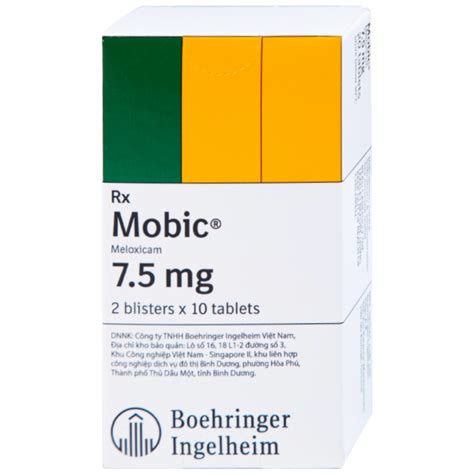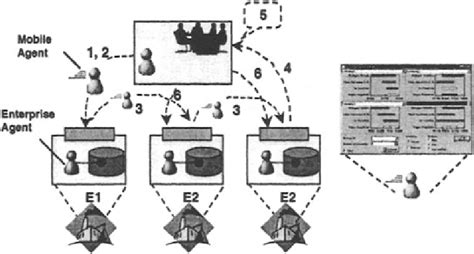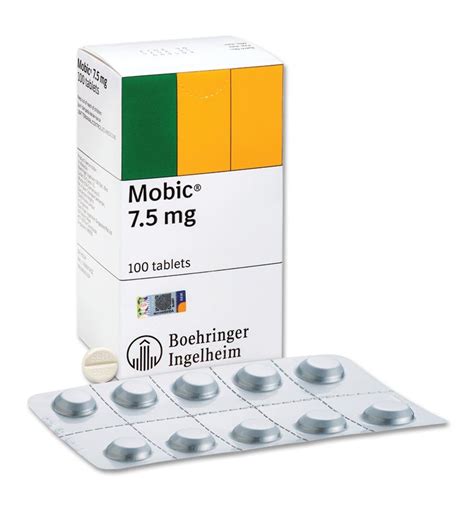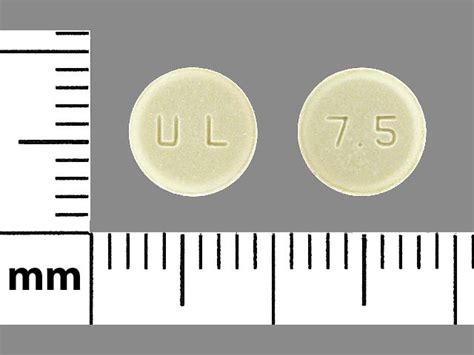Intro
Discover what Mobic is, a meloxicam-based medication, and learn about its uses, benefits, and side effects in reducing inflammation and pain, particularly for osteoarthritis, rheumatoid arthritis, and juvenile arthritis sufferers.
Mobic, also known as meloxicam, is a nonsteroidal anti-inflammatory drug (NSAID) used to treat various conditions, including arthritis, ankylosing spondylitis, and osteoarthritis. It belongs to the class of oxicam NSAIDs, which work by inhibiting the production of prostaglandins, substances in the body that cause pain, inflammation, and fever. By reducing the production of these prostaglandins, Mobic helps alleviate symptoms associated with inflammatory conditions, such as joint pain, swelling, and stiffness.
The importance of understanding Mobic and its uses cannot be overstated, as it is a commonly prescribed medication for managing chronic pain and inflammation. With the rising prevalence of arthritis and other inflammatory conditions, it is essential to explore the benefits and risks associated with Mobic, as well as its potential interactions with other medications. Furthermore, individuals who are considering taking Mobic or are already using it should be aware of its side effects, dosage, and administration to ensure safe and effective use.
In recent years, there has been a growing interest in the development of new treatments for inflammatory conditions, and Mobic has been at the forefront of this research. Its efficacy in reducing inflammation and pain has been well-documented, and it has become a staple in the treatment of various conditions, including rheumatoid arthritis, osteoarthritis, and ankylosing spondylitis. As research continues to uncover the benefits and risks of Mobic, it is crucial to stay informed about the latest developments and advancements in the field.
What is Mobic Used For

Mobic is primarily used to treat various inflammatory conditions, including osteoarthritis, rheumatoid arthritis, and ankylosing spondylitis. It is also used to manage pain, inflammation, and stiffness associated with these conditions. Additionally, Mobic may be prescribed to treat other conditions, such as tendinitis, bursitis, and gout. Its anti-inflammatory and analgesic properties make it an effective treatment option for reducing pain and improving functional ability in individuals with inflammatory conditions.
Benefits of Mobic
The benefits of Mobic are numerous, and they include: * Reduced pain and inflammation * Improved functional ability * Decreased stiffness and swelling * Enhanced quality of life * Convenience of once-daily dosingMobic has been shown to be effective in reducing the symptoms of inflammatory conditions, allowing individuals to perform daily activities with greater ease and comfort. Its once-daily dosing schedule also makes it a convenient treatment option for individuals with busy lifestyles.
How Mobic Works

Mobic works by inhibiting the production of prostaglandins, which are substances in the body that cause pain, inflammation, and fever. It specifically targets the enzyme cyclooxygenase-2 (COX-2), which is responsible for producing prostaglandins. By inhibiting COX-2, Mobic reduces the production of prostaglandins, thereby alleviating symptoms associated with inflammatory conditions.
The mechanism of action of Mobic is complex and involves multiple pathways. However, its primary mode of action is through the inhibition of COX-2, which reduces the production of prostaglandins. This, in turn, leads to a decrease in pain, inflammation, and fever.
Side Effects of Mobic
While Mobic is generally well-tolerated, it can cause side effects, including: * Nausea and vomiting * Diarrhea and abdominal pain * Headache and dizziness * Increased risk of bleeding and ulcers * Allergic reactions, such as rash and itchingIt is essential to be aware of the potential side effects of Mobic and to report any concerns to a healthcare provider. In some cases, side effects may be severe and require medical attention.
Mobic Dosage and Administration

The dosage and administration of Mobic vary depending on the condition being treated and the individual's response to the medication. The typical dosage range for Mobic is 7.5-15 mg per day, taken orally with or without food. It is essential to follow the prescribed dosage and administration schedule to ensure safe and effective use.
Mobic is available in various formulations, including tablets, capsules, and injectable solutions. The choice of formulation depends on the individual's needs and preferences.
Interactions with Other Medications
Mobic can interact with other medications, including: * Blood thinners, such as warfarin * Diuretics, such as furosemide * Antihypertensive medications, such as beta blockers * Corticosteroids, such as prednisoneIt is crucial to inform a healthcare provider about all medications being taken, including over-the-counter medications and supplements, to minimize the risk of interactions.
Precautions and Warnings

Mobic is not suitable for everyone, and precautions and warnings should be taken into consideration. These include:
- Increased risk of bleeding and ulcers, particularly in individuals with a history of gastrointestinal disease
- Allergic reactions, such as anaphylaxis
- Increased risk of cardiovascular events, such as heart attack and stroke
- Potential for liver and kidney damage
It is essential to discuss any concerns or questions with a healthcare provider before taking Mobic.
Pregnancy and Breastfeeding
Mobic is not recommended during pregnancy, particularly in the third trimester, due to the potential risk of fetal harm. Additionally, Mobic should be used with caution in breastfeeding women, as it may pass into breast milk.Conclusion and Final Thoughts

In conclusion, Mobic is a commonly prescribed medication for managing chronic pain and inflammation. Its efficacy in reducing symptoms associated with inflammatory conditions has been well-documented, and it has become a staple in the treatment of various conditions. However, it is essential to be aware of the potential side effects, interactions, and precautions associated with Mobic to ensure safe and effective use.
We invite readers to share their thoughts and experiences with Mobic in the comments section below. Additionally, we encourage readers to share this article with others who may benefit from the information.
What is Mobic used for?
+Mobic is used to treat various inflammatory conditions, including osteoarthritis, rheumatoid arthritis, and ankylosing spondylitis.
What are the benefits of Mobic?
+The benefits of Mobic include reduced pain and inflammation, improved functional ability, and decreased stiffness and swelling.
What are the potential side effects of Mobic?
+The potential side effects of Mobic include nausea and vomiting, diarrhea and abdominal pain, headache and dizziness, and increased risk of bleeding and ulcers.
Can I take Mobic with other medications?
+It is essential to inform a healthcare provider about all medications being taken, including over-the-counter medications and supplements, to minimize the risk of interactions.
Is Mobic suitable for everyone?
+Mobic is not suitable for everyone, particularly individuals with a history of gastrointestinal disease, allergic reactions, or cardiovascular events.
